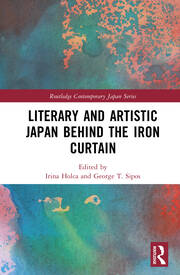Literary and Artistic Japan behind the Iron Curtain

Heute, am 1. Oktober 2025 erreichte mich eine Mail von Prof. Takashi Wada von der Mie-Universität, jetzt KYUSHU UNIVERSITY, Faculty of Social and Cultural Studies in Fukuoka, in der er die Publikation seiner Recherchen zur Übersetzung und Rezeption japanischer Literatur in der DDR ankündigt. Per Mail und bei seinem Aufenthalt in Berlin 2023 habe ich ihm Materialquellen vorgestellt und stand für Kommentare und Erklärungen als Zeitzeugin zur Verfügung. Es war eine sehr fruchtbare Zusammenarbeit für beide Seiten.
„My paper was made possible thanks to the great cooperation of you and Saito Eiko-sensei.
I’ll continue my research about the reception of modern Japanese literature in DDR.
今後とも、どうぞよろしくお願いいたします“。
Aus der Verlagswerbung:
Literary and Artistic Japan behind the Iron Curtain
Edited By Irina Holca, George T. Sipos
Copyright 2026, 1st Edition
Hardback
€140.00
eBook
€38.39
ISBN 9781041019275
252 Pages 28 B/W Illustrations
Published September 30, 2025 by Routledge
Germany Flag Free Shipping (7-14 Business Days)
shipping options
Description
This book examines the public perception, scholarly reception, and critical analysis of Japan through translations of its literature and artistic endeavors within the temporal frame and geopolitical confines of the countries that were either occupied or left under the influence of the Soviet Union after World War II.
By engaging with literary translations from Japanese into languages such as Romanian, Russian, Czech, Hungarian, German, and Slovenian, alongside art exhibits and performance shows focused on Japan, this book provides an original contribution to the field of Japanese studies in Eastern and Central Europe and the former Soviet space. In addition, by offering a multifaceted, multilingual, and multicultural approach to the diverse realities of countries from the former communist bloc, the book sheds light on the unique relationships they created with literary and artistic Japan, as well as the unique ways in which they attempted to lift the Iron Curtain and gaze at the Asian Other, a subject of both fascination and identification.
Approaching the subject of Japanese culture through the unique lens of former communist bloc nations, this book will appeal to students and scholars of Japanese studies and Japanese literature, particularly in the context of translations.
Table of Contents
Introduction. Forbidden Space(s): “Japan” in the Constructed Realm behind the Iron Curtain
Irina Holca and George T. Sipos
Part I: The Concrete and the Conceptual: Reception of Japan
1. Shifting Imagery on the Covers of Clavell’s Shōgun and the Romanian Reception of Japanese Visual Culture
Radu Leca
2. The “Rediscovery” of Japan in Hungary in the 1950s–1960s
Mária Ildikó Farkas
3. The Reception of Modern Japanese Literature in the German Democratic Republic: A Survey
Takashi Wada
4. Directions in the Slovene Translation of Japanese Literature during the Postwar Years
Nina Habjan Villarreal
5. The Hungarian Reception of The Hiroshima Panels and the Communist Desideratum for World Peace
Zsolt Petrányi
6. Return to the Myth: Japanese Literature in Soviet Moldova
Teodor Ajder
Part II:The Imagined: Japan as Symbol of Resistance
7. After the Freeze and the Thaw: Kawabata Yasunari’s Nobel Prize and the Soviet Rediscovery of Japan
Olga V. Solovieva
8. Rays behind the Iron Curtain: Japan, Cinema, and Bulgarian Socialist Culture
Andronika Màrtonova
9. Two Japanese Theater Classics in the Shadow of Socialist Realism in Hungary
Petra Doma
10. Sōsaku-hanga and ‘Progressive Japanese Art’ in Soviet Art History from the Late 1950s to the mid-1970s
Anna Guseva and Maria Yashkina
11. Japanese Poetic Expression against Communist Oppression: The Haiku/ Senryū of Dissident Karel Trinkewitz and Others
Lukas Bruna
12. The Reception of Clavell’s Shōgun: Fantasizing about Japan in Communist Romania
Alexandra Mustățea
 Beate Wonde
Beate Wonde